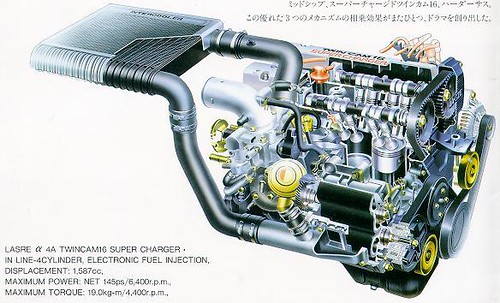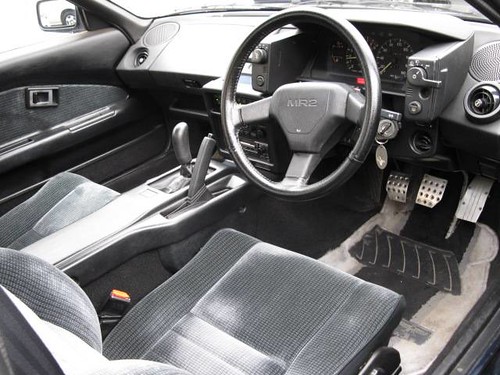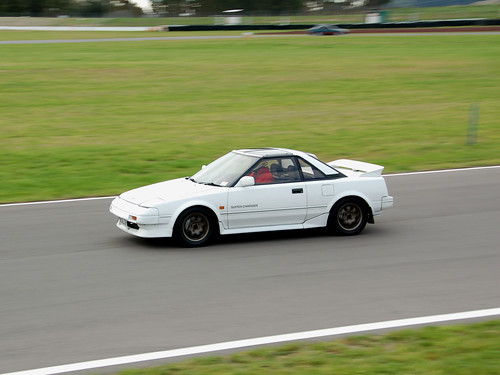In a recent Japanese Nostalgic Car forum poll it was stipulated that the AW11 Toyota MR2 made a suitable contender for the most significant Japanese car debuted in 1984. And while the ensuing thread turned into a lively (and at times heated) debate amongst various forum denizens over what specific vehicle traits embody the definition of “significant”, I personally couldn’t help but think how valid that contention actually was. Don’t need oodles of luggage space? Got a missus but no kids? Then why not vote for the MR2?
The concept-to-reality story of the first generation MR2 is splashed all over teh interwebs on various fansites and even on the ol’ wikipedia, so I’m loath to repeat what’s already been covered countless times before; however if you aren’t already clued up on how and why the Midship Runabout came to be, a nice little writeup can be found here. the things which particularly stand out to me include the debunking of the so-called “Lotus connection” (where the MR2 was said to have been designed and tuned by Lotus for Toyota) and the initial conception of the SA-X prototype as “a fuel-efficient drivers car that would be driven by people who enjoyed driving regardless of regulations or gas shortages” in response to the 70s oil crises – perhaps very much like today’s 2-seater Smart car. I’m somewhat glad Toyota didn’t ultimately end up running with that train of thought!
in hindsight, moving in the direction of creating a pure sports car instead proved far more beneficial to ‘em anyway. On the MR2′s release in 1984 the automotive world was taken by storm, having been treated to a preview of the car (then known as the SV-3) at the 1983 Tokyo Motor Show. Euro-car snobs today often scoff at the ruthless efficiency and clockwork reliability of Japanese vehicles, writing these traits off as a byproduct of soulless, mass-produced design. Because nothing says “passion” more than having to fix your Fiat on the side of state highway 1 in the middle of the night when a spring inside your carburettor decided to explode, oh yes. I’d rather enjoy driving the car without it unexpectedly breaking down because the wind decided to change direction.
But there was no mistaking that by 1983 Japan had overcome its ’60s and ’70s image as a “copycat of foreign technology”; pouring massive amounts of money into R&D combined with the start of the electronics boom allowed manufacturers like Toyota to produce, for possibly the first time, a so-called niche vehicle-for-two with many technological features yet with the safety and (most importantly) reliability standards of any other regular passenger car.

1983 Toyota SV-3 concept
Also happening to debut in 1983 (what an awesome year) was Toyota’s 130ps 4A-GE engine – again, no prior introduction of said product is required. Some say that it was the 4A-GE’s initial success in the Corolla (and Carina/Celica) which inspired Toyota to slot it between the rear struts of the MR2 a year later, while others note that it was only logical given the MR2 was itself based on the Corolla. the top of the range manual G-Limited model weighed only 940kg without sunroof, so for whichever reason combining a small and light chassis with a small yet somewhat powerful engine proved to be another great move.

Gee, I wonder what sort of engine this is?
one can’t go past the AW11 without noticing its quirky looks either. At first the proportions may appear a bit stubby, but I personally think of it as a bit of a “snubfighter”, taking the wedgey = aerodynamic design principles of the early 1980s and running completely wild with ‘em (coefficient of drag was only 0.34, reasonable by the standards of the day).Everywhere you look, you see triangles. And of course, chicks dig pop-up lights!
It even looks and feels like a spaceship inside, right down to the swoopy lines of the dashboard and recessed instrument cluster. A clean-slate design is truly evident here as there isn’t much shared between the MR2 and other Toyotas of the era, save for a couple of switches, the steering wheel and perhaps the air vents. the cabin is compact as expected yet never feels too cramped nor claustrophobic, and the raised section between the seats is initially confounding but drivers soon get used to sharing elbow space with the person next to them.
In true Japanese fashion and somewhat contrary to reports about lack of practicality there are a multitude of small interior storage spaces to put stuff into, and while you won’t be using the MR2 to move your girlfriend’s couch there’s still plenty of room in the boot and frunk for luggage and the like. If you’re feeling especially adventurous I’ve actually seen folks strap things to the engine cover, although the raised bonnet vents on the supercharged model can be a headache to get around…
Supercharged you ask? But of course!
Perhaps in response to numerous motoring journos clamouring for a bit more oomph, in 1986 Toyota released the kouki MR2, now with the addition of a small Roots blower amongst other changes (optional removable T-top glass roof, different tail lights, front valance spoiler, etc). While peak power of the 4A-GZE only rose 15ps over the N/A 4A-GE, the amount of torque on-tap increased by 25% – with 80% of that available as low as 2000rpm – and dramatically transformed the acceleration and handling characteristics of the already light chassis.

how to wake up a 4A-GE? strap a blower on the side!
Toyota’s natural response was to set the car up for a bit more understeer from the factory, while stiffening the body and suspension… and having owned both N/A and SC versions of the AW11 I can tell you that the difference is immediately noticeable, especially when cornering under power. There are some who say that the added weight and reinforcing in the supercharged models (dry mass rose to 1100kg in the glass roof G-Limited manual versions) make them feel a lot less nimble, and while this may be true I’ve found that the sweet acceleration more than makes up for it, and any deficit in handling can be solved by upgrading the suspension – I definitely would if I wasn’t already content with doing as little to my MR2 as possible, being a daily driver.
There are also those who say dumping the blower in favour of a turbo is a much better base for modification, but again I’ve found that I’d rather move my foot just a fraction and have instant torque for zipping around town; it never fails to put a grin on my face. Besides turbos are so commonplace now, there’s definitely a certain mystique to owning something with a supercharger instead.
So there you have it: my brief take on the first generation MR2. It rightfully deserves a place amongst the most significant Japanese cars of 1984 (if not of the ’80s as a whole) and yes I prefer having one over the “people’s choice” AE86 Levin/Trueno anyday. though if Toyota had decided to stick the 4A-GZE into the latter, maybe I’d… hmm, let’s not go there. And while the AW11 is somewhat unaffected by the so-called takumi tax, as you can probably guess tidy examples are now worth a fair amount in Japan let alone places like NZ, the UK and the States where the car enjoys a cult following – prices for a low-km, unmolested manual supercharged hardtop model are enough to make one’s eyes water.
And to further the idea of the AW11 being an iconic car of the ’80s, one even found its way into a recent music video for La Roux, a ‘retro synthpop’ band from the UK. Even though I generally like throwback ’80s stuff, I’m afraid this particular band ain’t my cup of tea. watch it here on Youtube (and try not to cringe)
| technical specs: | ||
| Toyota AW11 MR2 | prior-term G-Limited | latter-term G-Limited SC |
| Engine: | 4A-GELU Belt-driven DOHC 16 valve EFI, naturally aspirated |
4A-GZELU Belt-driven DOHC 16 valve EFI, supercharged with intercooler |
| Bore x stroke (mm): | 81.0 x 77.0 | 81.0 x 77.0 |
| Displacement: | 1.6 litres (1587cc) | 1.6 litres (1587cc) |
| Compression ratio: | 9.4:1 | 8.0:1 |
| Power: | gross 130ps/6600rpm | net 145ps/6400rpm |
| Torque: | 15.2kg-m/5500rpm | 19.0kg-m/4400rpm |
| Dry weight (5MT hardtop version): |
940kg | 1070kg |
| Released: | August 1984 | August 1986 |
First photo courtesy of FOREST RICE-FIELD 4416





how many kw does the stock AW11 push out?
ps (or Pfederstarke) is metric horsepower, so divide the ratings in the article by 1.36 to obtain the kW figures.
130ps = 96kW
145ps = 107kW
also note that the 130ps figure is ‘gross’ whilst 145ps is ‘net’ which relates to how each power figure was obtained (net is with all ancillaries and belts attached e.g. waterpump, A/C etc, gross is not). The 145ps net figure is probably around 160ps gross, at a rough guesstimate.
I just got one of these little cars, gotta say, they are fantastic!! I went from a turbo supra to a supercharged MR2 and I have to say, wow. just wow. the little car is ridiculous, its light, fast as all hell, nimble(r than my supra) now all it needs to make it truly fantabulistic is power steering and twin chargers… (supercharger AND turbo)